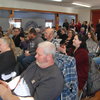Westerlo to receive over $1.6M for broadband implementation
WESTERLO — After months of lobbying and waiting, the good news for Westerlo residents is finally here: Their town will receive $1,687,500 from the federal government to lay down fiber-optic cable and greatly expand broadband access.
Congressman Paul Tonko — who made the request to the House Committee on Appropriations on behalf of the town, along with nine other big projects in his district — announced today that all 10 funding requests were approved and included in the federal spending bill. The total funding to be delivered to the Capital Region through these requests is $14,447,500, with Westerlo’s being the fourth-most expensive.
Now, Westerlo officials turn their attention to spending the money. Before it has access to the grant itself, the town will first need to expend its required contribution of $562,500. Supervisor Matt Kryzak told The Enterprise this week that that money is ready to go, and that solicitations to companies interested in providing service — MidTel and Mid-Hudson — have been sent out.
But, because of inflation, the price of certain commodities has shot up, meaning that the original projected benefit of delivering broadband access to 900 homes and businesses may be “slightly decreased,” Kryzak said.
“My goal is to purchase the materials first before they get so high we can’t afford them,” Kryzak said. “That money should be spent very quickly and then we should be able to get the remainder of the grant and actually do the installation of the cable.”
The good news is that, according to Nasdaq, the average price of fiber-optic cable itself has remained pretty stable since at least 2004. But the cost of compensation for private industry workers went up 4.4 percent in 2021, according to the Bureau of Labor Statistics, and the cost of low-sulfur diesel in the Central Atlantic area went up $1.61 between last summer and now, a 46-percent increase, according to the United States Energy Information administration.
“Obviously, we’re going to try to get as many homes served per mile as possible,” Kryzak said. “That will get us the greatest number of people served … I don’t know exactly what that looks like at this point, but that’ll be part of the whole negotiation. Once we get a contract with somebody to actually run the fiber and do all that work, part of that [job] will be mapping and figuring out how to get the biggest bang for our buck.”
Wider impact
Westerlo is not alone in its struggle to improve internet access for its rural residents. In the midst of the COVID-19 pandemic, the pains of slow or absent connections in communities like the Hilltowns became crystal clear — a fact that was not lost on Tonko, who, when meeting with Westerlo residents and officials last year as he was getting ready to bring their concerns to Congress, compared the need for broadband to that for electricity in the 1930s.
“President [Franklin] Roosevelt, when he went to Georgia for his treatments, would see outlandish lack of services, and he said, ‘That’s not America as we know it,’” Tonko said then of the origins of the Rural Electrification Act. “So, today, the modern-day fight for utilities is broadband. Doctors need to read X-rays … and students shouldn’t be going to a library parking lot to do their homework, and businesses need to have access to modern-day technology.”
Among the Hilltowns, Rensselaerville has the lowest connection rate, with 9 percent of its total population lacking a computer at home and 16 percent lacking internet connection despite having a computer, according to a digital-equity map recently published by the New York State Department of Education.
Berne is next, with around 9 percent of its population without a computer and 10 percent without internet. In Westerlo, 9 percent of residents don’t have a computer while 5 percent have no internet. In Knox, 2 percent of residents have no computer and more than 7 percent have no internet.
The data comes from the United States Census Bureau, making it highly likely that the internet problem in the Hilltowns isn’t adequately captured, since many residents who technically have both a web-device and an internet connection suffer from slow speeds that make it difficult to take advantage of either of those things.
Last year, Westerlo adopted a new comprehensive plan that stated 61 percent of survey respondents either didn’t have internet access at home or were unhappy with their speeds. Berne-Knox-Westerlo School Superintendent Timothy Mundell announced in 2020 that 30 percent of Berne-Knox-Westerlo’s student body had inadequate internet.
Because laying down new infrastructure in low-density areas is rarely profitable for telecommunications companies, small towns like Westerlo rely on subsidies. That Westerlo was able to not only get the attention of the federal government, but its money, too, shows that rural communities all over have a path forward.
“I think it was because we had a very well-laid-out plan and brought that to Congressman Tonko,” Kryzak said on Wednesday of Westerlo’s efforts. “... He said on the phone with me this morning that he was impressed with the amount of legwork that we have done, and the amount of planning that went into our grant application.”
Other projects
Other Albany County entities that got federal funds through Tonko are the University at Albany, the Albany County Sheriff’s Office, and the city of Cohoes.
Cohoes received $3 million to install floating solar panels on the Cohoes reservoir.
UAlbany received $1 million to buy RNA research equipment to help fight COVID-19 and advance new treatments for other diseases including Alzheimer’s and myotonic dystrophy.
The Albany County Sheriff’s Homeless Improvement Program, known as SHIP, received $500,000 to go towards providing people without homes remade unused jail cells where, in addition to food and shelter, they are provided mental-health and addiction services as well as job opportunities.



